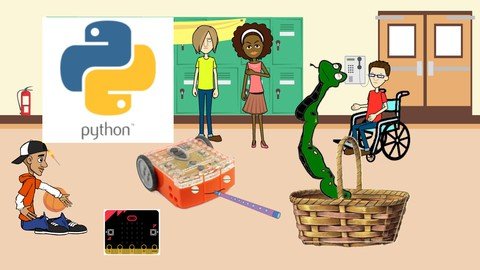
Published 1/2023
MP4 | Video: h264, 1280×720 | Audio: AAC, 44.1 KHz
Language: English | Size: 1.04 GB | Duration: 1h 41m
Suitable for beginners from 11 years old! Get Help From Funny Animated Cartoons and Robots (Edison and Micro:bit)
What you’ll learn
Learn how to use Python 3 the right way
Create your own basic programs with python
Correctly execute operations in Python
Understand programming structures
Learn about loop structures and conditionals
Nurture computational thinking
Develop problem-solving skills
Develop critical thinking
Understand technology
Understand that learning from mistakes is vital.
Develop learning by doing skills
Expand your creativity
Realize that persistence is rewarded
Requirements
You have to be able to operate a computer at a basic level
A pair of headphones could be helpful
Description
Python is considered to be one of the most popular programming languages on the planet. It is also a programming language in great demand in the field of information technology. If we add the fact that it is a programming language that is very easy to learn, then we already have several reasons to start our learning adventure immediately and without delays!This e-course is intended for students from 11 years old.Includes, among other tools, short funny cartoon–style video clips, quizzes, crosswords, exercises, solutions of the exercises, educational games, projects, accompanying documents, and slides.A special feature of the videos contained in these educational resources is that they are short cartoon films where each hero has a very unique and humorous personality.The educational resources you will find in this e-course also include educational robotics activities as Edison Robot can be programmed with Python. This means that the student sees his or her code come to life, which helps him or her to achieve the educational goals of each unit.The latest addition is the integration of activities with the Micro: bit microcontroller, which may also be programmed with (micro) Python.If a user does not own an Edison robot or/and Micro:bit he or she may skip the corresponding sectionsAfter the completion of this e-course you will be able to:• Understand critical concepts relating to computing and the typical activities involved in creating a program.• Understand and use computational thinking techniques like problem decomposition, pattern recognition, abstraction and algorithms to analyze a problem and develop solutions.• Write, test, and modify algorithms for a program using flowcharts and pseudocode.• Understand key principles and terms associated with coding and the importance of well-structured and documented code.• Understand and use programming constructs like variables, data types, and logic in a program.• Improve efficiency and functionality by using iteration, conditional statements, procedures, and functions, as well as events and commands in a program.• Test and debug a program and ensure it meets requirements before release.
Overview
Section 1: Computational Thinking & Programming
Lecture 1 Computing & Computational Thinking
Lecture 2 Computer Programming
Section 2: Introducing Python & Variables
Lecture 3 Install and start Python
Lecture 4 IDLE programs
Lecture 5 Variables
Section 3: Calculations & in-built functions
Lecture 6 Programming Structures
Lecture 7 Expressions
Lecture 8 In-built functions & modules
Section 4: Python and Turtle Programming
Lecture 9 Introduction to Object Oriented Programming
Lecture 10 Turtle Module
Section 5: Edison Robot – Get Familiar and Set Up
Lecture 11 Edison Robot – Introduction
Lecture 12 Barcodes
Lecture 13 Edison & Python
Lecture 14 Moving Edison
Section 6: Micro:bit Introduction & Programming
Lecture 15 Micro:bit Intro
Lecture 16 Micro:bit & Python
Section 7: Lists, other Collection Data Types & Iterations
Lecture 17 Lists, tuples and Arrays
Lecture 18 Iterations
Lecture 19 Micro:bit & Collection Data Types and Iterations
Section 8: Logical Expressions and Selection Structure
Lecture 20 Logical Expressions
Lecture 21 Selection Structure
Section 9: Loops and While Repetition
Lecture 22 Loops
Section 10: Functions & Algorithm Description
Lecture 23 Flow Charts & Pseudocode
Lecture 24 Functions
Section 11: So, how the story ends?
Lecture 25 So, how the story ends?
Section 12: Project: Autonomous Parking
Lecture 26 The Problem of Automatic Parking
Lecture 27 Problem Solving Methodology
Kids or teens aged 11 to 18 years old may attend this course under the supervision of a guardian or a teacher.,Teachers. Ideal for blended learning in flipped classrooms,Fathers, mothers or guardians may purchase this course for their kids,Adults may use this course to understand the basics of Python
Password/解压密码www.tbtos.com